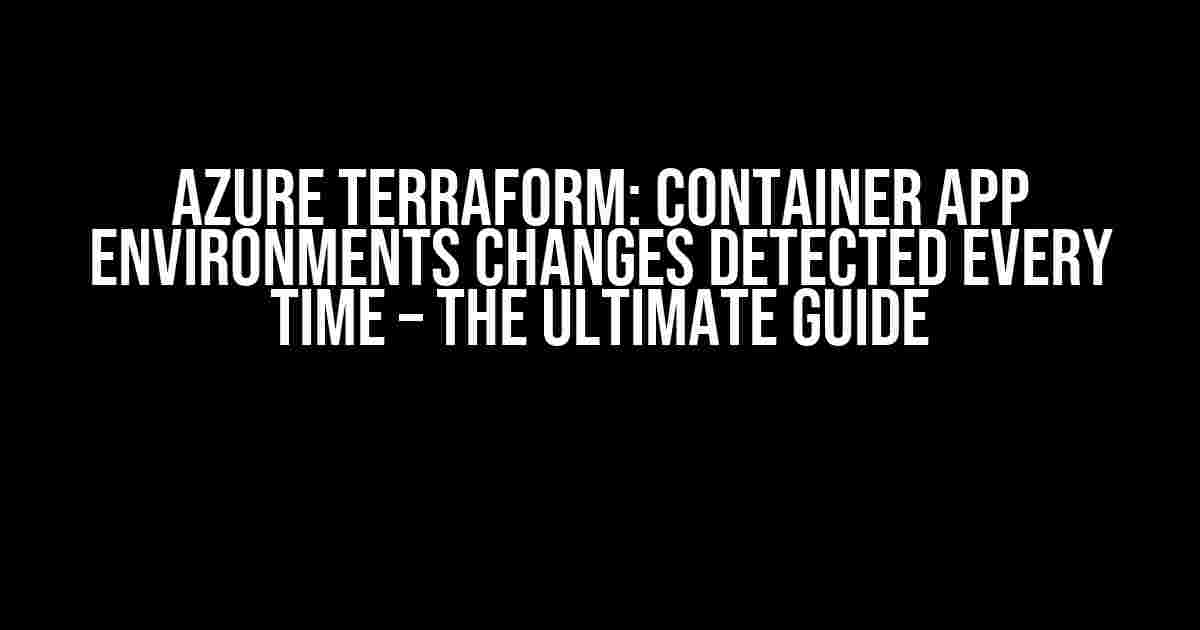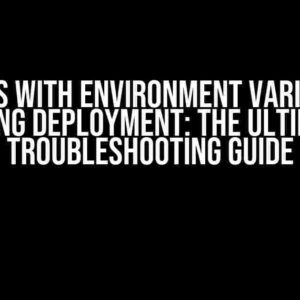Have you ever encountered the frustrating issue of Azure Terraform detecting changes to your Container App Environments every time you run a deployment? You’re not alone! In this article, we’ll dive into the world of Azure Terraform and Container App Environments, exploring the reasons behind this phenomenon and providing step-by-step solutions to overcome it.
What are Azure Terraform and Container App Environments?
Azure Terraform is an infrastructure-as-code (IaC) tool that enables you to define and manage cloud infrastructure using human-readable configuration files. Container App Environments, on the other hand, are a managed platform in Azure that allows you to deploy and manage containerized applications.
The Problem: Changes Detected Every Time
When you use Azure Terraform to deploy a Container App Environment, you might notice that Terraform detects changes to the environment every time you run a deployment, even when no actual changes have been made. This can lead to unnecessary updates, increased deployment times, and even errors.
Cause 1: Terraform’s Default Behavior
Terraform, by design, is a stateful tool that maintains a snapshot of your infrastructure. When you run a deployment, Terraform compares the desired state (defined in your configuration files) with the actual state of your infrastructure. If there are any differences, Terraform updates the infrastructure to match the desired state.
# Terraform configuration file (main.tf)
resource "azurerm_container_app_environment" "example" {
name = "example-container-app-env"
resource_group_name = "example-resource-group"
location = "West US"
}
In the case of Container App Environments, Terraform detects changes every time due to the way it handles the environment’s configuration. Specifically, Terraform stores the environment’s configuration as a JSON object in its state file. When you run a deployment, Terraform compares the JSON object in its state file with the actual environment configuration in Azure. If there are any differences, even if it’s just a minor change in the JSON structure, Terraform detects a change and updates the environment.
Cause 2: Azure APIs and HTTP ETags
Azure APIs use HTTP ETags to track changes to resources. When you retrieve an Azure resource using the Azure API, the API returns an ETag that represents the resource’s current state. If you update the resource and then retrieve it again, the ETag will be different, indicating that the resource has changed.
When Terraform interacts with Azure APIs to deploy a Container App Environment, it retrieves the environment’s configuration using the Azure API. The API returns an ETag that Terraform stores in its state file. On subsequent deployments, Terraform retrieves the environment’s configuration again and compares the ETag with the one stored in its state file. If the ETags differ, Terraform detects a change and updates the environment.
Solutions
Now that we’ve identified the causes, let’s explore the solutions to overcome the “changes detected every time” issue:
Solution 1: Use the `lifecycle` Meta-Argument
Terraform provides a `lifecycle` meta-argument that allows you to customize the lifecycle of a resource. By setting `ignore_changes` to `all`, you can tell Terraform to ignore any changes to the resource.
# Terraform configuration file (main.tf)
resource "azurerm_container_app_environment" "example" {
name = "example-container-app-env"
resource_group_name = "example-resource-group"
location = "West US"
lifecycle {
ignore_changes = [all]
}
}
This solution works by telling Terraform to ignore any changes to the Container App Environment, effectively preventing Terraform from detecting changes every time.
Solution 2: Use the ` timeouts` Meta-Argument
Another solution is to use the `timeouts` meta-argument to specify a timeout for the update operation. By setting a sufficiently high timeout, you can reduce the likelihood of Terraform detecting changes every time.
# Terraform configuration file (main.tf)
resource "azurerm_container_app_environment" "example" {
name = "example-container-app-env"
resource_group_name = "example-resource-group"
location = "West US"
timeouts {
update = "30m"
}
}
This solution works by giving Terraform more time to update the Container App Environment, reducing the likelihood of changes being detected.
Solution 3: Implement Idempotence
Idempotence is a concept in Terraform that ensures that applying the same configuration multiple times has the same effect as applying it once. By implementing idempotence, you can reduce the likelihood of Terraform detecting changes every time.
# Terraform configuration file (main.tf)
resource "azurerm_container_app_environment" "example" {
name = "example-container-app-env"
resource_group_name = "example-resource-group"
location = "West US"
# Implement idempotence by storing the environment's configuration in a local file
provisioner "local-exec" {
command = "az containerapp env show -n example-container-app-env -g example-resource-group -o json > environment.json"
}
# Use the stored configuration to update the environment
provisioner "local-exec" {
command = "az containerapp env update -n example-container-app-env -g example-resource-group --config-file environment.json"
}
}
This solution works by storing the Container App Environment’s configuration in a local file and then using that file to update the environment. By doing so, Terraform can compare the desired state with the actual state, reducing the likelihood of changes being detected.
Best Practices
To avoid the “changes detected every time” issue, follow these best practices:
-
Use a consistent naming convention for your Container App Environments to reduce the likelihood of Terraform detecting changes due to naming differences.
-
Implement idempotence by storing the environment’s configuration in a local file and using it to update the environment.
-
Use the `lifecycle` meta-argument to ignore changes to the Container App Environment.
-
Set a reasonable timeout for the update operation using the `timeouts` meta-argument.
-
Regularly review and update your Terraform configuration to ensure it reflects the actual state of your infrastructure.
Conclusion
Azure Terraform’s “changes detected every time” issue can be a frustrating problem, but by understanding the causes and implementing the solutions outlined in this article, you can overcome it. Remember to follow best practices, use the `lifecycle` and `timeouts` meta-arguments, and implement idempotence to ensure smooth deployments of your Container App Environments.
| Cause | Solution |
|---|---|
| Terraform’s default behavior | Use the `lifecycle` meta-argument |
| Azure APIs and HTTP ETags | Implement idempotence, use the `timeouts` meta-argument |
By following the guidelines outlined in this article, you’ll be well on your way to mastering Azure Terraform and Container App Environments. Happy deploying!
Frequently Asked Question
Get answers to the most asked questions about Azure Terraform container_app_environments changes detected every time.
Why does Terraform detect changes in container_app_environments every time I run it?
Terraform detects changes in container_app_environments because it uses a different object representation internally compared to the Azure API. This mismatch causes Terraform to see changes even when there aren’t any. It’s a known issue, and the Terraform team is working on a fix. Until then, you can use the `target` argument to focus on specific resources and reduce the noise.
Is there a way to ignore these changes and only apply actual changes to the infrastructure?
Yes, you can use the `ignore_changes` argument in your Terraform configuration file to ignore unwanted changes. For example, you can add `ignore_changes = [“container_app_environments”]` to your resource block. This tells Terraform to ignore any changes detected in the container_app_environments attribute.
Can I use the `terraform refresh` command to refresh the state and avoid detecting changes?
Yes, running `terraform refresh` can help update the Terraform state and reduce the noise. However, be cautious when using this command, as it can also overwrite local changes or undo previous changes. Make sure to review the changes carefully before applying them.
Are there any workarounds to avoid this issue in a CI/CD pipeline?
Yes, you can use a combination of `terraform plan` and `terraform apply` with the `-target` argument to scope the changes to specific resources. This can help reduce the noise and only apply actual changes to the infrastructure. Additionally, you can use Terraform’s built-in support for Azure DevOps and other CI/CD tools to streamline your pipeline.
Is this issue specific to Azure Terraform or does it affect other cloud providers as well?
This issue is specific to Azure Terraform and the container_app_environments resource. However, similar issues can occur with other cloud providers and resources due to differences in object representation and API implementations. It’s essential to stay up-to-date with Terraform releases and provider updates to address these issues.


